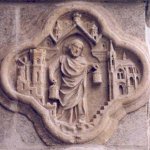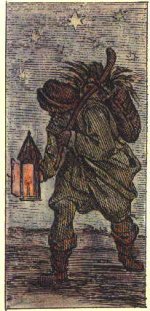You are using an out of date browser. It may not display this or other websites correctly.
You should upgrade or use an alternative browser.
You should upgrade or use an alternative browser.
IX L'Ermite
mythos
Although the figure in the Mitelli Hermit looks more like a workman coming home in the dark from the fields, with candle lantern, it is indeed one of my favourite 'Hermits'. I do wonder, given the few stars which sprinkle the night, whether it is merely meant to be a 'star' card. As I purchased my copy from Germany, and my High School German was far too long ago (and I was a lazy student of this language), I can translate little of the accompanying book. Such a complex language!
Though this is more related to the Pope, I find the inclusion of 2 Pope's in the Mitelli deck very interesting ... the standing Pope and the sitting Pope. Though the year of production of the original deck was 1718 or thereabouts, it does suggest that the schism was still an issue alive, at least, in Mitelli's mind.
The second pic is more for amusement ... My Dad as model for a seated Hermit. He was in one of his 'naughty-lad' moods and refused to stand still, but I like the idea of the Hermit seated. Remove the surrounds, change the clothing, picture the broom as a staff, add both the lantern and the hourglass ... for both seem very relevant and therefore requiring inclusion and we have it.
Why both lantern and hourglass? My father will soon be 85, and in spite of a brain hemmorhage, talks at length of issues related to such topics as reincarnation, karma, the akashic record, the meaning of life, essentially... he is pursuing the process of reordering his life's experience into a meaningful package, and the awareness of his own mortality is foremost in all our minds ... thus we have both the shining of the light on our inner and outer worlds to find meaning, and the freshness in mind of one's own mortality. Consequently, to me, both symbols are relevant.
Given the Diogenes story (thanks for the link Tom) my humour wishes to glue a rubber chicken somewhere on the picture, but that will have to wait for my 'spoof' deck which, I suspect will follow, or run parallel to this current creation. I already that the fool tumbling off the cliff because the dog has leapt up and pushed him over. Maybe an old dog lying next to my Hermit/Wise Old Man a là Jung/Diogenes figure would suffice?
And Kaz, I too, find the Soprafino Hermit a particularly superb image ... the deck as a whole. And, thank you too for your Jung as Hermit .... it is an idea that crossed my mind, but my skills in portraiture are not sufficient to have made that possible.
I had often wondered about the snake that appears on the Hermit card in a number of decks, and had not made the Moses connection. My knowledge of Old and New Testament is sorely lacking having not been brought up in a Judeo-Christian household.
Having just completed a 'Hermit' Year, there certainly is the element of initiation present, and of transformation, both of which are relevant in snake symbolism. Still, all of this is meandering off the TdM track. But then, I guess that it goes back to catboxer's original comments about the evolution of tarot from Chronos image to Christian hermit, and in later years, into a range of images male and female both.
Fascinating discussion guys, my thanks
mythos
Though this is more related to the Pope, I find the inclusion of 2 Pope's in the Mitelli deck very interesting ... the standing Pope and the sitting Pope. Though the year of production of the original deck was 1718 or thereabouts, it does suggest that the schism was still an issue alive, at least, in Mitelli's mind.
The second pic is more for amusement ... My Dad as model for a seated Hermit. He was in one of his 'naughty-lad' moods and refused to stand still, but I like the idea of the Hermit seated. Remove the surrounds, change the clothing, picture the broom as a staff, add both the lantern and the hourglass ... for both seem very relevant and therefore requiring inclusion and we have it.
Why both lantern and hourglass? My father will soon be 85, and in spite of a brain hemmorhage, talks at length of issues related to such topics as reincarnation, karma, the akashic record, the meaning of life, essentially... he is pursuing the process of reordering his life's experience into a meaningful package, and the awareness of his own mortality is foremost in all our minds ... thus we have both the shining of the light on our inner and outer worlds to find meaning, and the freshness in mind of one's own mortality. Consequently, to me, both symbols are relevant.
Given the Diogenes story (thanks for the link Tom) my humour wishes to glue a rubber chicken somewhere on the picture, but that will have to wait for my 'spoof' deck which, I suspect will follow, or run parallel to this current creation. I already that the fool tumbling off the cliff because the dog has leapt up and pushed him over. Maybe an old dog lying next to my Hermit/Wise Old Man a là Jung/Diogenes figure would suffice?
And Kaz, I too, find the Soprafino Hermit a particularly superb image ... the deck as a whole. And, thank you too for your Jung as Hermit .... it is an idea that crossed my mind, but my skills in portraiture are not sufficient to have made that possible.
I had often wondered about the snake that appears on the Hermit card in a number of decks, and had not made the Moses connection. My knowledge of Old and New Testament is sorely lacking having not been brought up in a Judeo-Christian household.
Having just completed a 'Hermit' Year, there certainly is the element of initiation present, and of transformation, both of which are relevant in snake symbolism. Still, all of this is meandering off the TdM track. But then, I guess that it goes back to catboxer's original comments about the evolution of tarot from Chronos image to Christian hermit, and in later years, into a range of images male and female both.
Fascinating discussion guys, my thanks
mythos
Attachments
Strange2
mythos said:The second pic is more for amusement ... My Dad as model for a seated Hermit. ......Why both lantern and hourglass? My father will soon be 85, and in spite of a brain hemmorhage, talks at length of issues related to such topics as reincarnation, karma, the akashic record, the meaning of life, essentially... he is pursuing the process of reordering his life's experience into a meaningful package, and the awareness of his own mortality is foremost in all our minds ... thus we have both the shining of the light on our inner and outer worlds to find meaning, and the freshness in mind of one's own mortality. Consequently, to me, both symbols are relevant.
Mythos,
What a wonderful homage to both your Dad and the archetype of the Hermit! Thanks for sharing that. I can tell you are cherishing this special time in your Dad's life, and the lessons he has taught and continues to show you.
I am in a Hermit year myself, and having had my father recently pass on after several years of debilitating Alzheimer's disease, I have frequently reflected on the lessons that our elders show us, and the light on the path that they shine for us. The Light from the Hermit's lantern is both the reflection of the time's past, and the Shining of the Eternal Now.
Shine On!
mythos
I was in a Hermit Year up until 31/8, the year in which Dad had a brain haemorrhage which has seriously affected his memory. How difficult it must have been for you with your Dad, and how appropriate that you are doing a Hermit year Strange2. I found myself reading (or re-reading) much of Jung ... a Hermit figure if ever there was one, during my Hermit year, and it was my father who first introduced me to Jung as a child at the breakfast table.
Your experience really adds to the idea of the Hermit as reflecting Chronos, mortality and the journey into the inner world that needs to be down to come to terms with our own and others mortality.
Take care
mythos
Your experience really adds to the idea of the Hermit as reflecting Chronos, mortality and the journey into the inner world that needs to be down to come to terms with our own and others mortality.
Take care
mythos
Melanchollic
L' Hermite as Hermes Trismegistus
The Geomantic figure Albus (White) is sort of the Geomantic equivalent of the Hermit card, being named for the whiteness of an old man's beard. This figure is ruled by the planet Mercury, which is of course Hermes.
The Geomantic figure Albus (White) is sort of the Geomantic equivalent of the Hermit card, being named for the whiteness of an old man's beard. This figure is ruled by the planet Mercury, which is of course Hermes.
DoctorArcanus
Melanchollic said:The Geomantic figure Albus (White) is sort of the Geomantic equivalent of the Hermit card, being named for the whiteness of an old man's beard. This figure is ruled by the planet Mercury, which is of course Hermes.
Thank you, Melanchollic!
I am currently fascinated by Geomancy, and I find this note very interesting.
Is this relation Albus/Hermit your own idea or is it based on other sources?
In any case, it is excellent
On the other end, I think the "historical" Hermit (e.g. Visconti-Sforza and some ancient Bologna cards) is related to Time and to Saturn.
Marco
Rosanne
Hi! Levi apparently associated it to the Hebrew letter Teth or a Capuchin monk and Prudence (Huson)
Robert Place attributes it in his Alchemical deck to Hermes through the number 9 through completion and wisdom; especially as nine is three cubed and the last of the integral numbers. Place does not mention this in his book The Tarot.
Cavendish in his book says The hermit has since 1500's been associated with legendary wise men, like Hermes, King Solomon and Christian Rosenkreuz.
Golden dawn says he is the one the three wise men.
I had a great deal of trouble associating him with Saturn, as apparently was typical, when looking astrologically at this card. Instead I gave him to Jupiter as the Jupiter the Light- in fact in hindsight, I would rather have given him to Wisdom/Hermes because he was by Justice in the last triangle of three. Thanks I will reconsider. ~Rosanne
Robert Place attributes it in his Alchemical deck to Hermes through the number 9 through completion and wisdom; especially as nine is three cubed and the last of the integral numbers. Place does not mention this in his book The Tarot.
Cavendish in his book says The hermit has since 1500's been associated with legendary wise men, like Hermes, King Solomon and Christian Rosenkreuz.
Golden dawn says he is the one the three wise men.
I had a great deal of trouble associating him with Saturn, as apparently was typical, when looking astrologically at this card. Instead I gave him to Jupiter as the Jupiter the Light- in fact in hindsight, I would rather have given him to Wisdom/Hermes because he was by Justice in the last triangle of three. Thanks I will reconsider. ~Rosanne
Melanchollic
DoctorArcanus said:Thank you, Melanchollic!
I am currently fascinated by Geomancy, and I find this note very interesting.
Is this relation Albus/Hermit your own idea or is it based on other sources?
In any case, it is excellent
On the other end, I think the "historical" Hermit (e.g. Visconti-Sforza and some ancient Bologna cards) is related to Time and to Saturn.
Marco
Thanks Marco,
It is my own, as far as I know, though the two share obvious similarities.
The way I work with these sorts of correlations is rather fluid. I think a card can have several 'aspects' that can inform the meaning and 'round out' the character.
When I correlate L' Hermite, Albus, and Mercury, I'm not excluding his Saturnine qualities. Also, I'm not suggesting that the Tarot was intended to express the Geomantic figures, per say.
Yeah, it's slightly schizophrenic, but it works for me.
The interesting thing is that Albus has a historical relation to Mercury, was created in the same time and place (more or less) as Tarot, and greatly resembles L' Hermite in meaning. It give us a precedent.
I think the inherent commonality of the images, and their being from roughly the same cultural paradigm, make astrology and geomancy a useful indicator of what the various Tarot 'characters' could have meant in that time and place.
Melanchollic
DoctorArcanus
Melanchollic said:Thanks Marco,
It is my own, as far as I know, though the two share obvious similarities.
The way I work with these sorts of correlations is rather fluid. I think a card can have several 'aspects' that can inform the meaning and 'round out' the character.
When I correlate L' Hermite, Albus, and Mercury, I'm not excluding his Saturnine qualities. Also, I'm not suggesting that the Tarot was intended to express the Geomantic figures, per say.
Yeah, it's slightly schizophrenic, but it works for me.
I think I understand what you mean.
Aleister Crowley put it in this way: "One must constantly keep in mind the bivalence of every symbol. Insistence upon either one or other of the contradictory attributions inherent in a symbol is simply a mark of spiritual incapacity" (Edited to add: "a Mark of spiritual incapacity" could be a good signature for me
Melanchollic said:The interesting thing is that Albus has a historical relation to Mercury, was created in the same time and place (more or less) as Tarot, and greatly resembles L' Hermite in meaning. It give us a precedent.
I think the inherent commonality of the images, and their being from roughly the same cultural paradigm, make astrology and geomancy a useful indicator of what the various Tarot 'characters' could have meant in that time and place.
I am not sure that the Geomantic figures and Tarot come from the same time and place. I suspect Geomancy comes Asia and from a very ancient time (possibly before Christ?), while I think that Tarot comes from Europe, XV Century.
But I am sure that Geomancy and Astrology tell us something about the ancient interpretation of Tarot. Astrology was definitely important for Tarot, since the first painted decks.
Agrippa writes that Albus "signifies a man of a short stature, broad brest, and gross arms, having curled or crisped hair, one of a broad full mouth, a great talker and babler, given much to use vain and unprofitable discourse, but one that is merry, joyous and jocond, and much pleasing to men."
To me this sounds more like the fool. Could you please tell us more about "the inherent commonality of the images"?
Marco
PS: I would like a new thread to discuss Geomancy with you and all those interested
Ayumi
The Pythagoreans calles the Ennead (9) "Thrice Perfect", because the Triad is perfect and the Ennead is the Triple Triad. This brings to mind "Thrice Great" (Trismegitus) Hermes. Nine would seem to be the best number to use if you wanted to put a number to Hermes Trismegitus.
Marco, I've noticed that Agippa differs a lot from others in his interpretation of the Geomantic figures. He has a peculiarly negative view of Albus, which is generally viewed as being lucky, especially in money and business, and as Melanchollic points out, is related to knowledge and patience.
I'd be up for a Geomancy thread!
Ayumi
Marco, I've noticed that Agippa differs a lot from others in his interpretation of the Geomantic figures. He has a peculiarly negative view of Albus, which is generally viewed as being lucky, especially in money and business, and as Melanchollic points out, is related to knowledge and patience.
I'd be up for a Geomancy thread!
Ayumi




